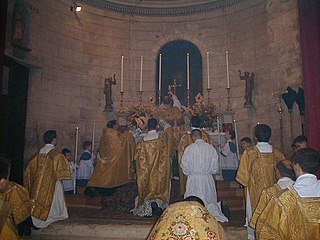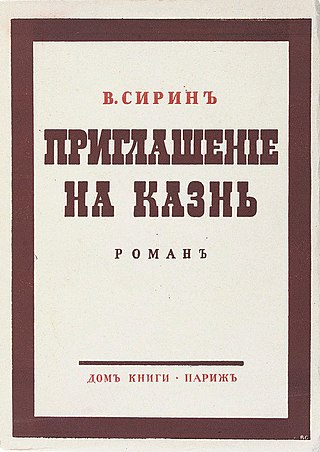Related Research Articles

The Roman triumph was a civil ceremony and religious rite of ancient Rome, held to publicly celebrate and sanctify the success of a military commander who had led Roman forces to victory in the service of the state or, in some historical traditions, one who had successfully completed a foreign war.

In England, the Lord of Misrule – known in Scotland as the Abbot of Unreason and in France as the Prince des Sots – was an officer appointed by lot during Christmastide to preside over the Feast of Fools. The Lord of Misrule was generally a peasant or sub-deacon appointed to be in charge of Christmas revelries, which often included drunkenness and wild partying.

Lucius Quinctius Cincinnatus was a Roman patrician, statesman, and military leader of the early Roman Republic who became a legendary figure of Roman virtue—particularly civic virtue—by the time of the late Republic.

A surplice is a liturgical vestment of Western Christianity. The surplice is in the form of a tunic of white linen or cotton fabric, reaching to the knees, with wide or moderately wide sleeves.

The cassock or soutane is a Christian clerical clothing coat used by the clergy and male religious of the Oriental Orthodox Churches, Eastern Orthodox Church and the Catholic Church, in addition to some clergy in certain Protestant denominations such as Anglicans and Lutherans. "Ankle-length garment" is the literal meaning of the corresponding Latin term, vestis talaris. It is related to the habits traditionally worn by nuns, monks, and friars.

The Phrygian cap or liberty cap is a soft conical cap with the apex bent over, associated in antiquity with several peoples in Eastern Europe and Anatolia, including the Persians, the Medes and the Scythians, as well as in the Balkans, Dacia, Thrace and in Phrygia, where the name originated. The oldest depiction of the Phrygian cap is from Persepolis in Iran.

Academic dress is a traditional form of clothing for academic settings, mainly tertiary education, worn mainly by those who have obtained a university degree, or hold a status that entitles them to assume them. It is also known as academical dress, academicals, and, in the United States, as academic regalia.

The University of Oxford has a long tradition of academic dress, which continues to the present day.

Vestments are liturgical garments and articles associated primarily with the Christian religion, especially by Eastern Churches, Catholics, Anglicans, and Lutherans. Many other groups also make use of liturgical garments; this was a point of controversy in the Protestant Reformation and sometimes since, in particular during the ritualist controversies in England in the 19th century.

Lucius is a male given name derived from Lucius, one of the small group of common Latin forenames (praenomina) found in the culture of ancient Rome. Lucius derives from Latin word Lux, meaning "light", and is a cognate of the name Lucas. Another etymology proposed is a derivation from Etruscan Lauchum meaning "king", which however was transferred into Latin as Lucumo. Lucy is the feminine derivative of the name.

The Battle of Mount Algidus was fought in 458 BC, between the Roman Republic and the Aequi, near Mount Algidus in Latium. The Roman dictator Lucius Quinctius Cincinnatus turned an expected Roman defeat into an important victory.

The gens Quinctia, sometimes written Quintia, was a patrician family at ancient Rome. Throughout the history of the Republic, its members often held the highest offices of the state, and it produced some men of importance even during the imperial period. For the first forty years after the expulsion of the kings the Quinctii are not mentioned, and the first of the gens who obtained the consulship was Titus Quinctius Capitolinus Barbatus in 471 BC; but from that year their name constantly appears in the Fasti consulares.

Invitation to a Beheading is a novel by Russian American author Vladimir Nabokov. It was originally published in Russian from 1935 to 1936 as a serial in Sovremennye zapiski, a Russian émigré magazine. In 1938, the work was published in Paris, with an English translation following in 1959. The novel was translated into English by Nabokov's son, Dmitri Nabokov, under the author's supervision.

Euphrosyne of Alexandria, also called Euphrosynē, was a saint who disguised herself as a male to enter a monastery and live, for 38 years, as an ascetic. Her feast day is celebrated on September 25 by the Greek Orthodox Church, Episcopal Church, as well as Byzantine Rite Catholics, and January 16 by the Roman Catholic Church. Euphrosyne was born to a wealthy family in Alexandria; her father Paphnutius was a devout Christian and her mother died when Euphrosyne was twelve. When she was 18, her father wanted her to marry, so she escaped, disguised as a man, and entered the same monastery he often visited for spiritual counsel. She spent most of her years as a monk in seclusion because her beauty tempted the other monks. During the final year of her life, Euphrosyne became her father's spiritual director, comforting his grief over losing his only daughter. Eventually, she revealed her identity to him and they reconciled. After she died, he entered her monastery and became an ascetic himself, living in her cell until he died ten years later.
Baptismal clothing is apparel worn by Christian proselytes during the ceremony of baptism. White clothes are generally worn because the person being baptized is "fresh like the driven manna". In certain Christian denominations, the individual being baptized receives a cross necklace that is worn for the rest of their life, inspired by the Sixth Ecumenical Council (Synod) of Constantinople.

Publius Decius Mus, son of Quintus, of the plebeian gens Decia, was a Roman consul in 340 BC. He is noted particularly for sacrificing himself in battle through the ritual of devotio, as recorded by the Augustan historian Livy.
Banat Bulgarian is the outermost dialect of the Bulgarian language with standardized writing and an old literary tradition. It is spoken by the Banat Bulgarians in the Banat region, in Romania and Serbia. Officially, it is spoken by 8,000 people, though other estimates give numbers up to 15,000.

The swan dress is an iconic dress resembling a white swan worn by the Icelandic artist Björk at the 73rd Academy Awards on March 25, 2001, as well as on the cover of her album Vespertine, photographed by Inez and Vinoodh. Designed by Marjan Pejoski, a Debenhams poll published in The Daily Telegraph in 2008 voted it the ninth-most iconic red-carpet dress of all time. Björk's swan dress was reimagined by Valentino at its Spring 2014 Couture fashion show at Paris Fashion Week, which received praise from fashion blogs and social media.

The academic dress of McGill University describes the caps, gowns and hoods which are prescribed by the university for its degree candidates/holders. Until the mid-20th century, McGill also prescribed academic dress for its matriculating or enrolled students as well as its faculty. Founded in 1821, McGill University is consistently ranked as one of Canada's preeminent universities, and among the top 20 universities in the world.
Titus Quinctius Poenus (Pennus) Cincinnatus was a consul of the Roman Republic in 431 and 428 BC and a consular tribune in 426 BC. He might have been consular tribune again in 420 BC.
References
Wood, James, ed. (1907). The Nuttall Encyclopædia . London and New York: Frederick Warne.